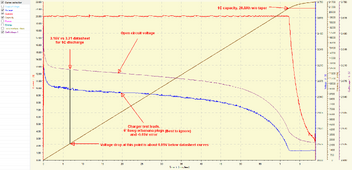sunshine_eggo
Happy Breffast!
@RCinFLA
Hopefully, you can explain something.
I've recently tested 73 older CALB 40Ah cells for capacity, internal resistance and self-discharge.
History:
Probably 10+ years old.
Part of a 10kWh aftermarket 04-09 Prius Plug in Hybrid pack operating in Phoenix AZ, unknown mileage.
When car was sold, pack was removed, balance boards on each cell drained cells to 0.6V for weeks/months.
5 cells (don't remember which) were loose and were NOT discharged - resting around 3.3V.
Gentle charges until >3.0V then individual 20A charge/discharge to measure capacity... all north of 20Ah.
Stored fully charged for about 3 years.
Aforementioned testing of 73 cells.
Sit for a few weeks.
On a whim, I decided to cycle a cell with sense leads attached as all prior testing was intended for comparative purposes. This particular cell tested 19.6Ah on the prior test using voltage as sensed by the test leads rather than sense leads.
This cell tested 1.5mΩ on a YR1030 vs. 0.8mΩ datasheet.
The following three curves are three consecutive discharges (20A to 2.5V, taper current to 1A, terminate) of voltage vs. time, with Ah noted:
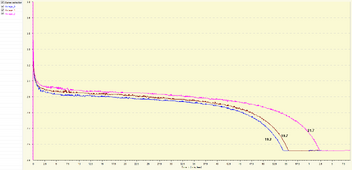
This was a 10A charge to 3.65V with a tail current of 1A (approximately 0.05C), 19.7Ah input, curves as expected:
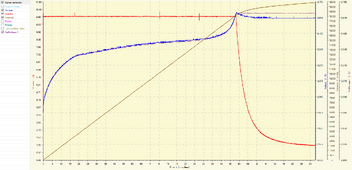
This generated the following 19.7Ah discharge (20A to 2.5, hold and taper current to 1A), curves as expected:
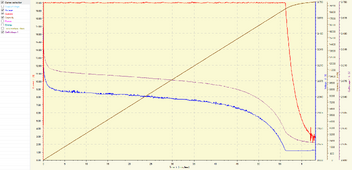
Here's where it gets weird... the next charge, 27.5Ah input, WTF???:

What's really noteworthy is the crazy extended "absorption" period.
Following discharge, 21.7Ah, curves as expected.:

Subsequent charge, 21.8Ah, curves as expected.:
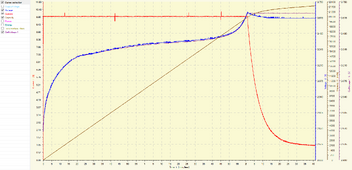
final discharge, 21.7Ah:

Summary:
CHG1/DCH1: top off/19.2 (3.65V charge terminated at 2A, not 1A tail)
CHG2/DCH2: 19.7/19.7 (3.65V, 0.05C)
CHG3/DCH3: 27.5/21.7 (3.65V, 0.05C, WTF?)
CHG4/DCH4: 21.7/21.7 (3.65V, 0.05C)
All discharges were 20A to 2.5VOC, taper to 1A, terminate initiated 1 minute after termination of charge.
Note that the charger logic starts tapering at TEST lead voltage of 2.50V and 2.66VOC and tapers current as it approaches 2.5VOC.
WTF happened? How did the cell accept an additional 6Ah of input in such an odd way, and how did capacity bump up by 10% with cycling after this odd charge? I use this charger on a very regular basis, and confirmed it's reasonably accurate with a fluke voltmeter and a CL800 clamp DC ammeter, so I don't believe this is related to a hardware issue.
Hopefully, you can explain something.
I've recently tested 73 older CALB 40Ah cells for capacity, internal resistance and self-discharge.
History:
Probably 10+ years old.
Part of a 10kWh aftermarket 04-09 Prius Plug in Hybrid pack operating in Phoenix AZ, unknown mileage.
When car was sold, pack was removed, balance boards on each cell drained cells to 0.6V for weeks/months.
5 cells (don't remember which) were loose and were NOT discharged - resting around 3.3V.
Gentle charges until >3.0V then individual 20A charge/discharge to measure capacity... all north of 20Ah.
Stored fully charged for about 3 years.
Aforementioned testing of 73 cells.
Sit for a few weeks.
On a whim, I decided to cycle a cell with sense leads attached as all prior testing was intended for comparative purposes. This particular cell tested 19.6Ah on the prior test using voltage as sensed by the test leads rather than sense leads.
This cell tested 1.5mΩ on a YR1030 vs. 0.8mΩ datasheet.
The following three curves are three consecutive discharges (20A to 2.5V, taper current to 1A, terminate) of voltage vs. time, with Ah noted:

This was a 10A charge to 3.65V with a tail current of 1A (approximately 0.05C), 19.7Ah input, curves as expected:

This generated the following 19.7Ah discharge (20A to 2.5, hold and taper current to 1A), curves as expected:

Here's where it gets weird... the next charge, 27.5Ah input, WTF???:

What's really noteworthy is the crazy extended "absorption" period.
Following discharge, 21.7Ah, curves as expected.:

Subsequent charge, 21.8Ah, curves as expected.:

final discharge, 21.7Ah:

Summary:
CHG1/DCH1: top off/19.2 (3.65V charge terminated at 2A, not 1A tail)
CHG2/DCH2: 19.7/19.7 (3.65V, 0.05C)
CHG3/DCH3: 27.5/21.7 (3.65V, 0.05C, WTF?)
CHG4/DCH4: 21.7/21.7 (3.65V, 0.05C)
All discharges were 20A to 2.5VOC, taper to 1A, terminate initiated 1 minute after termination of charge.
Note that the charger logic starts tapering at TEST lead voltage of 2.50V and 2.66VOC and tapers current as it approaches 2.5VOC.
WTF happened? How did the cell accept an additional 6Ah of input in such an odd way, and how did capacity bump up by 10% with cycling after this odd charge? I use this charger on a very regular basis, and confirmed it's reasonably accurate with a fluke voltmeter and a CL800 clamp DC ammeter, so I don't believe this is related to a hardware issue.




